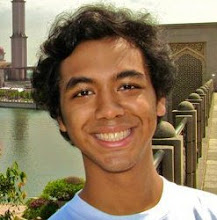As the second summative test of respi ended, my soul was freed from its chains. The huge burden suddenly vanished and everybody almost literally leapt with joy. If happiness were fuel, the collective happiness of my class could’ve sent a rocket filled with FPI over the solar system - but not back to Earth.
Last weekend, my family went on a very short vacation to Jogja and Solo in Central Java. Originally, we wanted a longer trip but our free time never line up perfectly. My dad only come back from KL every two weeks; my brother had already gone back to school; while I was just in the first days of my holiday. In the end, we had to make do with a two-days trip. Nevertheless, it was very memorable.
I took off from Soekarno-Hatta’s brand new Terminal 3, the tacky design of which deserves a bashing. Expect it soon in this blog. After landing in Jogjakarta’s Adi Sucipto airport, we went straight to Solo. First, we visited the grave of my paternal grandfather. It was located in a family cemetery reserved for members of the Solo royalty. My family is not closely related to the current king, but we can trace our roots to one of the kings in the past. In a very strange way, I felt comfortable going there. Perhaps it was the perfect weather and the merciful shade of the big tree beside the grave.
Next on our agenda was lunch. But the Earth’s rotation cannot keep up with our appetite so we had to find a distraction before going to lunch. We shopped at the Orion Bakery, famous for its unique Mandarijn cake. Near the shop is an old traditional market called Pasar Gede. Pasar means market, while Gede means big. So its name pretty much explains everything. What I like about it is that the city council preserves thehistorical building, even after a fire. Unlike in Jakarta, where we see bustling markets turned into half-hearted shopping centers.
Pasar Gede
Solo also boasts its own Keraton or palace compound. Despite having been to Solo more than ten times, I have never really visited it so this was my very first time. The Keraton is located near the alun-alun (city square), along with the Great Mosque of Solo. This setting is very common in Javanese cities although sometimes the mayor’s or governor’s office takes the Keraton’s place. We rented two becaks (cycle rickshaws) to go to the Keraton from alun-alun and also to go to Kampung Batik.
In the Keraton, there was this museum about the role of the kingdom’s role in fighting the Dutch invasion. The museum also houses many regalia from past kings. Next to the museum is the palace court. It is very amazing how the Keraton and its 300 abdi dalem (servants) can not only hold on to tradition but also still lead the people, at least spiritually, in this ever changing world. After the Keraton visit, the becak driver took us to Kampung Batik where more than a hundred local batik makers open their business.
Then came the moment we have been waiting for: lunch. In Tambak Segaran street, there is a satay restaurant that sells the best sate buntel in the world. Sate buntel is a variation of satay using minced meat wrapped in a thin layer of fat. OK, not so thin, but we don’t eat the fat anyway. The meat was very tasty and it is complemented by the sauce. The portion is very generous and just a plate of two satays satisfied our longing. A plate for each person, that is.
After lunch, we headed back to Jogjakarta. My time there will be covered in the second part.


0 comments:
Post a Comment